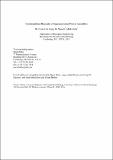| dc.contributor.author | Kim, Do-Nyun | |
| dc.contributor.author | Nguyen, Cong-Tri | |
| dc.contributor.author | Bathe, Mark | |
| dc.date.accessioned | 2017-05-02T18:53:17Z | |
| dc.date.available | 2017-05-02T18:53:17Z | |
| dc.date.issued | 2010-09 | |
| dc.date.submitted | 2010-09 | |
| dc.identifier.issn | 10478477 | |
| dc.identifier.uri | http://hdl.handle.net/1721.1/108611 | |
| dc.description.abstract | Supramolecular protein assemblies including molecular motors, cytoskeletal filaments, chaperones, and ribosomes play a central role in a broad array of cellular functions ranging from cell division and motility to RNA and protein synthesis and folding. Single-particle reconstructions of such assemblies have been growing rapidly in recent years, providing increasingly high resolution structural information under native conditions. While the static structure of these assemblies provides essential insight into their mechanism of biological function, their dynamical motions provide additional important information that cannot be inferred from structure alone. Here we present an unsupervised computational framework for the analysis of high molecular weight protein assemblies and use it to analyze the conformational dynamics of structures deposited in the Electron Microscopy Data Bank. Protein assemblies are modeled using a recently introduced coarse-grained modeling framework based on the finite element method, which is used to compute equilibrium thermal fluctuations, elastic strain energy distributions associated with specific conformational transitions, and dynamical correlations in distant molecular domains. Results are presented in detail for the ribosome-bound termination factor RF2 from Escherichia coli, the nuclear pore complex from Dictyostelium discoideum, and the chaperonin GroEL from E. coli. Elastic strain energy distributions reveal hinge-regions associated with specific conformational change pathways, and correlations in collective molecular motions reveal dynamical coupling between distant molecular domains that suggest new, as well as confirm existing, allosteric mechanisms. Results are publically available for use in further investigation and interpretation of biological function including cooperative transitions, allosteric communication, and molecular mechanics, as well as in further classification and refinement of electron microscopy based structures. | en_US |
| dc.description.sponsorship | Massachusetts Institute of Technology (MIT Faculty Start-up Funds) | en_US |
| dc.description.sponsorship | Massachusetts Institute of Technology (Samuel A. Goldblith Career Development Professorship) | en_US |
| dc.language.iso | en_US | |
| dc.publisher | Elsevier B.V. | en_US |
| dc.relation.isversionof | http://dx.doi.org/10.1016/j.jsb.2010.09.015 | en_US |
| dc.rights | Creative Commons Attribution-NonCommercial-NoDerivs License | en_US |
| dc.rights.uri | http://creativecommons.org/licenses/by-nc-nd/4.0/ | en_US |
| dc.source | Prof. Bathe via Howard Sliver | en_US |
| dc.title | Conformational dynamics of supramolecular protein assemblies | en_US |
| dc.type | Article | en_US |
| dc.identifier.citation | Kim, Do-Nyun, Cong-Tri Nguyen, and Mark Bathe. “Conformational Dynamics of Supramolecular Protein Assemblies.” Journal of Structural Biology 173, no. 2 (February 2011): 261–270. | en_US |
| dc.contributor.department | Massachusetts Institute of Technology. Department of Biological Engineering | en_US |
| dc.contributor.approver | Bathe, Mark | en_US |
| dc.contributor.mitauthor | Kim, Do-Nyun | |
| dc.contributor.mitauthor | Bathe, Mark | |
| dc.relation.journal | Journal of Structural Biology | en_US |
| dc.eprint.version | Author's final manuscript | en_US |
| dc.type.uri | http://purl.org/eprint/type/JournalArticle | en_US |
| eprint.status | http://purl.org/eprint/status/PeerReviewed | en_US |
| dspace.orderedauthors | Kim, Do-Nyun; Nguyen, Cong-Tri; Bathe, Mark | en_US |
| dspace.embargo.terms | N | en_US |
| dc.identifier.orcid | https://orcid.org/0000-0002-6199-6855 | |
| mit.license | PUBLISHER_CC | en_US |
| mit.metadata.status | Complete | |
